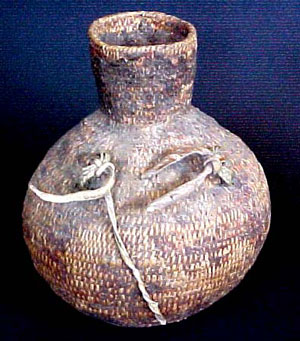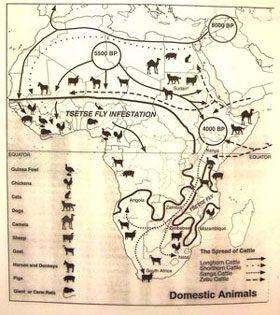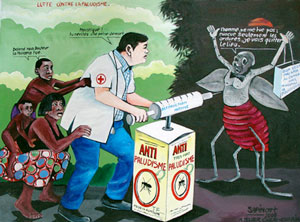
Different African environments and modes of adaptation shape the pattern of disease, prevention, and healing. Thus health is tied to divergent ways of life in differing environments. This exhibition section tells the audience that a society's general health is not derived from medicine and therapy, but from knowledge of the local environment and how to live with its hazards and make use of its resources. This knowledge has evolved over millennia, as a long-term journey, and may be understood as a type of practical science maintained from generation to generation through particular practices and diets. Display objects are utensils, tools, and symbols that are key to a way of life.

The subsection Foraging & Fishing, Pastoralism, Cultivation features large photos of livestock herds with herders, and of cultivators in their fields, to show these major and contrasting modes of making a living. A large map of Africa shows the somewhat overlapping boundary between herding and cultivation extending like a vast arc across the Sahel, eastern highlands, and southern Africa. From East African pastoral societies, displayed objects will include milk containers of different sizes used for milking; storage, and fermenting; wooden cattle bells and cattle tail fly wisps; spears and irikan clubs, and regalia, such as lion mane and feathered headdresses worn by Maasai warriors, the main protectors of the herds, jewelry worn for protection at different stages of life (such as the first pendant with special herbs that is blessed by a ritual specialist and given to a very young girl). Displayed objects from the wet savanna and rainforest regions will include fishing traps, and iron agricultural tools and pottery. The map will also show the distribution pattern of rainfall (high in the center, low or even absent in the Sahara, Kalahari, and Horn of Africa deserts), vegetation (rainforest, savanna, and scrub brush and desert).


The visitor, having grasped the basic features of the map of environments and mode-of-living adaptations, will be able to make the connection between them and two ancient endemic diseases, named in the title of the next subsection: Sleeping Sickness & Malaria. The first (scientifically known as trypanosomiasis), carried by the tsetse fly, affects both humans and large domesticated livestock over a wide area of the African continent. Small inset maps and charts will demonstrate how West African pastoralists such as the Fulani seasonally move their herds toward green pasture in otherwise dry areas and away from the fly infested regions; in the dry season they move their herds back toward agricultural lands where forage is available in the form of harvested stubble, while farmers benefit from the animal manure for their lands. This adaptive pattern has deep historic roots going back to the spread of bovines some eight thousand years ago across the Sahel. Around 5000 years ago, cattle herders moved south into East Africa when the tsetse fly belt moved west–no longer posing a threat to humans or animals–and a change in rainfall patterns facilitated the burgeoning of the savannas providing ideal conditions for cattle. Cattle herders spread into southern Africa around 2000 years ago. In Africa today cattle herding still forms an important part of the economic base.
Ironically, the non-cattle keepers, the farmers, carry the ancient human resistance to animal milk, known as lactose intolerance, considered close to a health problem in the modern world. Whereas the pastoralists, who gradually were able to digest animal milk—as early as 2000 years ago, according to current research--became lactose tolerant, considered “normal” in the modern world As for African cultivators who live in tsetse-infested territory, a text will explain their knowledge of settlement location and care, how they recognize a tsetse fly, and the story of wildlife eradication to control the tsetse fly in some precolonial cases of the southern savanna. By contrast, text will describe outbreaks of sleeping sickness epidemics—e.g., the Lower Congo--following settlement disturbances and forced labor migrations in the early colonial era.
The story of malaria is similar to that of sleeping sickness in that both are vector (insect)-borne micro-organisms that produce disease. Malaria is carried between humans by several species of mosquito who reproduce in still-standing water pools in and around human settlements. Thus the spread of sedentary agricultural villages and cities became the habitat in which malaria took root and spread. As in the case of sleeping sickness, malaria also engendered a biological adaptation in the form of the mutation that provided immunity in certain forms, and was lethal in others. This condition is known as “sickle-cell anemia” in the modern world and is known among African immigrants to the Western world.
This exhibition section has several levels of learning for the audience. Most generally, the visitor should learn that disease and health are in constant and dynamic relationship, defined in relative terms with particular points of reference in the environment and the living beings that reside in that setting. The visitor is invited to grasp this general principle in its particular version: Africa’s major adaptive lifestyles—herding (represented by an array of milk containers), cultivation (represented by various iron-made tools)—have a deep historical association to the endemic diseases of sleeping sickness and malaria. The attentive visitor will come to understand particular technical, genetic, and social mechanisms that emerged to provide adaptive advantage to the populations in question. Some visitors will be eager to learn the historical background of the health conditions they themselves harbor: lactose tolerance or intolerance, and sickle-cell anemia. The details of these insights will be repeated at greater length in exhibition websites and educational material.